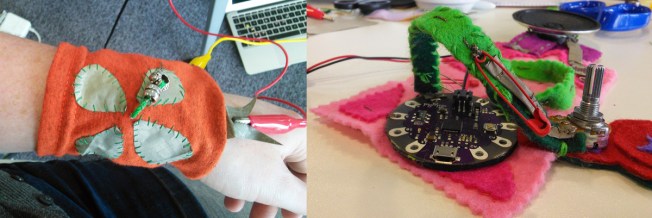Over the last two days I’ve been attending an MzTech Wearable Synthesizer workshop hosted by AIR Falmouth, an arm of Falmouth University modeled around the Pervasive Media Studio in Bristol. I was really exited about this opportunity to spend some quality time on further developing my understanding of Arduino coding and to tryout a Lillypad Arduino board and soft circuitry.

The workshop began with a quick introduction from the workshop facilitators (Katrin Baumgarten & Shauna Concannon) and an overview of examples from people like Di Maidstone, Imogen Heap and Hirsch & Mann.
From then on we were encouraged to take a hands on approach and get to know the Lillypad with some beginners experiments like the Blink and Button programmes (‘sketches’ in Arduino vocabulary). I learned how to decipher, adapt, write and rewrite sketches and start to get to grips with the process of writing, compiling, loading and executing the software. Having the basics explained like this set up a really comfortable environment to experiment further and to start to build soft switches and circuits using conductive thread, material and felt. By the end of day one, I had built a working Tone Pitch Follower using an LDR (light dependent resistor) as its input control and I was proud as punch!!

Having built up some really basic fluency and understanding of how these devices are setup (both in terms of software and components) makes the world of Arduino seem a lot less daunting! I’m aware that there are lots of self-paced tutorials online and through using the built in example sketches that come with Arduino 1.0.5 in the workshop, I’m realising the potential for how I could continue to develop my practical knowledge in this area. Even though I had used Arduino before to make minor adjustments to the Makey Makey, I hadn’t really clocked that there were lots of pre-loaded example sketches, many of which have links to full tutorials online. One of the things participating in this workshop drew my attention to is my own need to come together with others to get started – afterall, I could have followed along with tutorials like this online, couldn’t I? And as a keen auto didactic and regular user of MOOCs there must be a reason why I hadn’t already started exploring these things? This is possibly partly due to not making time to spend two days tinkering with things, partly due to not knowing where to start and partly to do with a complete lack of confidence in working with electronic components (something I have set myself the personal challenge to overcome this summer!). I realise that I also really enjoy being in a space alongside other people interested in learning the same things. The process of following, making and testing suits me to a tee as learning by doing, copying, adapting and a continuous prototyping is how I learn most successfully. I’m also aware that my desire for self-paced activity is sometimes just a desire to rush ahead and being in the workshop environment slows me down in a useful way, allowing me to consolidate what I’ve learned by helping others and completing things in a more step by step and methodical way.
 :: Some close-ups of my tilt switch & 3D approach to circuits!! ::
:: Some close-ups of my tilt switch & 3D approach to circuits!! ::
Alongside all of this, throughout the workshop, I was keenly aware of what any of this had to do with women or my being a woman. This is mainly due to the fact that the workshop had been advertised and recruited as “Coding For Women”, which at the outset seemed a little strange (and at odds with my own desires to provide open and accessible introductions to digital technology that feel approachable for anyone regardless of previous experience and/or gender) but I initially put down to a need to fulfill funding criteria. The title might assume that men already have access to this knowledge, which in my experience is not often the case. Those things aside, I was very interested to see how many people would be there when I turned up on Monday morning… and I was very pleasantly surprised and really impressed with the turnout. Speaking with one of the event’s organisers, Becca Gill, she was excited that the course’s over subscription showed a strong demand for this type of workshop in the area. So, are women in Cornwall poorly served by adult education / the potential to learning in less formal settings? Mainstream offering like art classes, watercolours or stained glass may work for a particular demographic but there is also a demand to a type of non traditional ‘making’ – challenging, out of the ordinary and stimulating.

This has spurred me on to think further about setting up some kind of maker group or meeting to provide this kind of environment for informal learning, mutual education and skill sharing. Penzance Maker Days / Maker Party anyone?
